|
Where Next?
How
a TCU liberal arts major came to be in charge of one of the Smithsonian's
top artifacts. The story of Valerie Neal '71.
By Rick
Waters '95

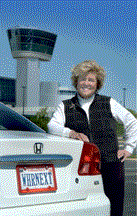 Vanity
license plates are essentially free in Virginia. That is, they cost little
more to register than standard tags issued by the government. Vanity
license plates are essentially free in Virginia. That is, they cost little
more to register than standard tags issued by the government.
So when Valerie
Neal '71 moved to suburban Washington, D.C., in 1989 to become the curator
of the Smithsonian Institution's "Where Next, Columbus?" exhibit at the
National Air and Space Museum, she knew just what she would get.
WHRNEXT.
Instantly,
her car became a moving billboard for the exhibit, which celebrated humanity's
spirit of discovery from the Nina, Pinta and Santa Maria to the space
shuttle and beyond. The license plate also served as a daily reminder
to Neal and others of the exhibit's looming deadline. Despite funding
troubles and fears of delay, Neal's team desperately wanted to push ahead,
make up ground and open "Where Next, Columbus?" before the end of 1992,
thus commemorating the quincentennial of the Spanish explorer's voyage
across the Atlantic.
"It became
a talisman," Neal recalled. "Sort of a good luck charm."
It must have
worked. The exhibit opened just before Christmas and was hailed a success,
even generating a book of essays about the future of space exploration,
edited by Neal.
After the
exhibit closed, the plate became a treasured memento, and some of Neal's
colleagues thought she might take it off her car for safe keeping. After
all, "Where Next" was over.
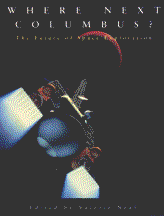 But
that thought never occurred to her. WHRNEXT had become a way of life. But
that thought never occurred to her. WHRNEXT had become a way of life.
About the
time she moved to Washington and started the exhibit, her 45-year-old
husband of 10 years had died from a long fight against lymphoma cancer,
and the city and the job were both a fresh start.
"It was just
me and my son, Bryan [Hassin], and we spent as much time together as we
could. And so that phrase became a personal motto for adventure, travel
and even our daily lives. We'd hop in the car, head to the grocery store,
the barber shop, the gas station, then say, 'Where next?' I'd take Bryan
to football practice or Scouts. 'Where next?' We traveled together on
business trips and vacations, and when we came back, we'd say, 'Where
next?' It helped to work through the grief, but I think it was also the
expression of our adventurous spirit."
*
* *
More than
a decade later, Neal's car is now a shiny, white Honda, but it still has
that license plate. Neal herself still has the same optimistic, take-life-head-on
bravado. She uses both to zip through Washington's side streets and crowded
freeways between the National Air and Space Museum's facility on the National
Mall in downtown and its new complex at Dulles Airport.
These days,
Neal is in the space history division and must be in both places frequently.
From her office on the third floor of the Mall complex she plans exhibits,
keeps tabs on the latest developments at NASA and occasionally acquires
a long-sought treasure for the museum.
But this
spring, her most pressing work is 25 miles west at the museum's $300 million
Stephen F. Udvar-Hazy Center, which opened in December 2003 and houses
the Smithsonian's largest aviation and aerospace artifacts, including
the nation's first space shuttle, Enterprise. It is Neal's baby.
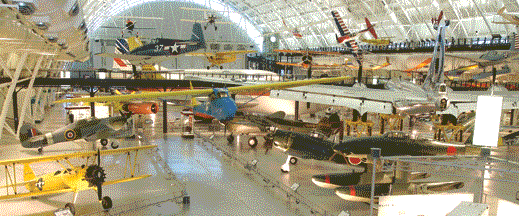
The museum
was thrilled to get the enormous treasure in 1985 when NASA retired it
from service. But because of its size, Enterprise has remained in a hangar
at Dulles until six months ago.
Truth is,
the "nation's attic" has been cramped for decades. Some jokingly
call the Mall facility the "Air and No Space Museum" because
it can display only about 10 percent of the institution's holdings.
The Udvar-Hazy
(OOD-var HAH-zee) Center changes all that. Named for a Hungarian-born
airline tycoon who gave the Smithsonian $65 million to start construction,
the new facility allows the museum to take 80 percent of its collection
out of storage and showcase it in grand fashion.
The building
itself is an attraction. Just hundreds of feet from the nearest runway
at Dulles, the Hazy Center looks like an airport terminal with its impressive
steel architecture and dark glass windows. A 164-foot observation tower
offers views of all the runways. There's also an IMAX theater. Even the
entrance and signage have been designed to look like an arrival and departure
area, with the main section resembling an airplane fuselage.
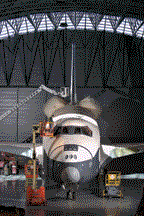 It's
almost too much to take in at once. Three football fields long and 10
stories high, the main hangar will eventually hold more than 200 aircraft
and hundreds of small aviation artifacts. The ceiling arches alone hold
1,000 tons, enabling aircraft to be displayed overhead. It's
almost too much to take in at once. Three football fields long and 10
stories high, the main hangar will eventually hold more than 200 aircraft
and hundreds of small aviation artifacts. The ceiling arches alone hold
1,000 tons, enabling aircraft to be displayed overhead.
And that
is just what the museum has done. An early goal was to allow visitors
to experience the scale inherent in artifacts of this size. Imagine a
massive unobstructed space with aircraft displayed on three levels, some
suspended from the rafters on steel wires, giving the appearance of a
sky full of planes flying in all directions. (Many are even situated in
positions that the craft actually employed during bombing runs and attack
sorties.)
For a closer
look, visitors can ascend metal skywalks to come nose-to-nose with the
flying machines. Larger aircraft rest on the floor where people can move
among them.
All told,
the facility is almost 40 million cubic feet.
"Can you
see why it's such an adventure coming to work every day?" Neal said with
a grin and shrug one spring morning. Her eyes twinkle at the thought.
"I can't imagine working anywhere else."
During a
busy week in the middle of March, she is solving a couple of mysteries
with Enterprise. When a nearly 30-year-old spacecraft needs to
be cleaned and touched up, what kind of paint is right for the job? The
answer is not just a matter of what looks nice. It has to be the exact
type of paint used from 1974-76 when the shuttle was constructed. Preservation
and historical accuracy hang in the balance.
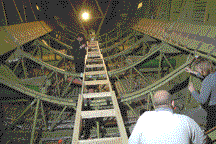 To
help, Neal has welcomed six NASA contractors from Boeing for the week.
They'll help her find the answer, but they also have business of their
own. Occasionally, NASA wants to know what kind of condition Enterprise
is in, and this week the agency has dispatched the Boeing team to collect
data, specifically on nonmetallic substances. To
help, Neal has welcomed six NASA contractors from Boeing for the week.
They'll help her find the answer, but they also have business of their
own. Occasionally, NASA wants to know what kind of condition Enterprise
is in, and this week the agency has dispatched the Boeing team to collect
data, specifically on nonmetallic substances.
Over time,
rubber becomes brittle. Plastics show wear. Paint chips. Knowing how long
these materials will last gives NASA an idea of their durability on shuttles
still in service. Meanwhile, the museum benefits by getting an expert
opinion on how to refurbish its treasure.
"This is
the best materials test bed NASA has, and it's frozen in time in this
hangar," said Jerry Blackburn of the Boeing team and a former NASA engineer
who worked on Enterprise in the 1970s. "A lot of materials on the
shuttle were invented for it. Thus no one really knows how long they will
remain functional, and here we are almost 30 years later and many of the
materials are still in good condition."
Based on
Neal's research and the team's findings, the conclusion is that Enterprise
is in better shape than expected and that a polyurethane paint should
be used to coat the payload bay doors. A solution of liquid soap and water
will clean the rest.
"It's in
NASA's interest to have the vehicle in pristine condition and in the museum's
interest to have NASA's expertise," Neal said. "NASA still sees this shuttle
as an asset, and they think enough of us to leave it in our care."
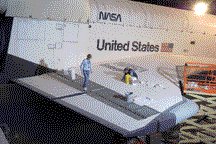 Neal
still marvels at how a vehicle that has n't had a major operational test
since 1979 still has technical value. But it does. Enterprise has
become a bank of spare parts for the other shuttles. In 2003, NASA removed
sections of the leading edge of both wings and the landing gear doors
for use in the Columbia accident investigation. They'll be returned
later this year. Neal
still marvels at how a vehicle that has n't had a major operational test
since 1979 still has technical value. But it does. Enterprise has
become a bank of spare parts for the other shuttles. In 2003, NASA removed
sections of the leading edge of both wings and the landing gear doors
for use in the Columbia accident investigation. They'll be returned
later this year.
Also amazing
about Enterprise is that it is the only shuttle to have never entered
outer space.
"Its first
function was approach and landing tests," Neal said. "Although it's called
an orbiter, it never flew in space. And you'd never hear NASA call it
this, but it is really a giant glider because it has no propulsion system.
It was used as a test vehicle to demonstrate that a winged spacecraft
would handle and land like an aircraft."
NASA used
a modified 747 to take Enterprise up piggy-back style and release
it. As it descended, astronaut pilots performed systems checks and monitored
performance characteristics. Later, it underwent launch vibration tests
and was retired from primary service after only two years.
"But it
was the flagship for the rest of the shuttle fleet," Neal said. "Columbia
in 1981, Challenger in 1983, Discovery in 1984, Atlantis
in 1985 and Endeavor in 1992. All owe their existence to Enterprise."
Interestingly,
Enterprise was originally to be called Constitution, but
two weeks before its debut, "Star Trek" fans launched a massive letter
writing campaign to change the name to Enterprise. It stuck.
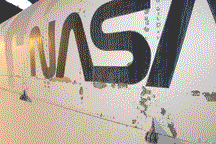 After
its main test phase ended in 1979, Enterprise has been a showpiece,
making appearances at the 1983 Paris Air Show and the 1984 World's Fair
in New Orleans. After
its main test phase ended in 1979, Enterprise has been a showpiece,
making appearances at the 1983 Paris Air Show and the 1984 World's Fair
in New Orleans.
Enterprise
had been out of sight in storage on Dulles Airport property since 1985
until Hazy opened. Over the years, dust, flaking paint and other signs
of aging appeared, but refurbishing was impossible in a crowded storage
hangar. Now that it has a new home, it's Neal's job to get the shuttle
cleaned and repainted for permanent display.
Enterprise
now rests in the yet-to-be-opened James S. McDonnell Space Hangar, which
is attached to the main aviation hangar. It is off-limits to the public
while Neal and the museum's preservation team do their work, but visitors
can still view the shuttle from behind a rope barrier, coming within 20
feet of the nose.
Soon, 135
other major space treasures, such as rockets and missiles standing on
end, will join Enterprise in a completed space hangar, scheduled
to open by late fall. It will feature four primary exhibit areas: civil
applications (meteorology, computers, communication satellites), space
science (astronomy, solar and planetary science), military applications
(rockets) and human space flight (from Mercury, Gemini and Apollo forward).
Enterprise will be showcased in the center.
Neal and
her colleagues have already mapped out all of the large artifacts and
most of the hundreds of smaller ones, including flight suits, tools, even
urine and fecal collection devices. She has written text and selected
photographs and graphics for the display panels, which designers are preparing
over the summer. The exhibit will go into final production and installation
by late fall.
"We're in
for a busy summer," she said.
TCU and
beyond
Liberal arts
majors aren't supposed to be in charge of space shuttles. They're lovers
of history and art and literature, not hard science. If that's true, then
Valerie Neal is different. She loves them all.
Consider
her Who's Who yearbook quote from 1971, her senior year: "I think the
most important attitude a college student develops is one of inquiry and
critical judgment."
 So
maybe it makes perfect sense that she is a caretaker of some of the country's
most precious artifacts. Behind all the degrees and publishing she has
achieved, Neal still thinks of herself as an English and history major
who loves exploring ideas and people and things. So
maybe it makes perfect sense that she is a caretaker of some of the country's
most precious artifacts. Behind all the degrees and publishing she has
achieved, Neal still thinks of herself as an English and history major
who loves exploring ideas and people and things.
Because she
is so conversant in space terminology and concepts, most scientists she
corresponds with assume her background is in astrophysics or aerospace
engineering.
"What I
truly enjoy is discovery," she said. "That's what a liberal arts education
at TCU taught me more than anything -- learning how to learn."
Neal came
to Fort Worth from Hot Springs, Ark., where her family lived in roughly
the same neighborhood as an older boy named Bill Clinton. An outstanding
academic record afforded her several college choices, but it was an interest
in travel that prompted her to leave the state. She also sought a smaller
school that offered a variety of educational choices.
She received
two substantial scholarships, one to TCU and one to Vanderbilt. Ultimately,
TCU offered more and its Disciples of Christ heritage -- the church of
her family's faith -- made the difference.
Most of her
liberal arts training and inspiration came in the Honors Program. She
counts Fred Erisman, Lorraine Sherley, Judith Suther, Betsy Colquitt,
Maurice Boyd, Ron Flowers, Gus Ferre and Martha Ackerman in her "personal
pantheon of TCU professors."
"Every course
I had inspired me. Honors Seminars such as The Nature of Society and The
Nature of Values were a real foretaste of graduate school. Miss Sherley's
Interrelation of the Arts course was such a revelation. What we were really
doing was learning how to think, learning how to learn. We were opening
and exercising our minds on ideas.
"When I
came to TCU, I had a good base, but I gained so much depth and breadth
in literature and fine arts and history and philosophy. I was really encouraged
to explore beyond what was in the books to synthesize and make sense of
it, to make connections and think creatively."
 She
recalls an essay exam given by philosophy professor Gus Ferre in which
the only question was something like: "Imagine Plato, Jefferson and
Henry Adams having dinner together and discussing education. Write how
their conversation might go." She
recalls an essay exam given by philosophy professor Gus Ferre in which
the only question was something like: "Imagine Plato, Jefferson and
Henry Adams having dinner together and discussing education. Write how
their conversation might go."
"It was
very challenging, and it allowed us to show what we knew and understood
in a cogent way. That kind of thinking goes into exhibit work," she said.
"As curator, one of my strengths is writing. I love language, and I see
writing as an exercise in the architecture and poetry and music of words.
I learned that at TCU. My classes in art appreciation and music appreciation
enriched my study of literature and history. This interdisciplinary insight
helps me work with designers because I have an eye for composition, whether
it is visual or verbal."
Like she
is now, Neal was an exceptional all-round talent at TCU. After her first
two semesters, she received the Borden Freshman Award for academic excellence.
She joined Pi Beta Phi sorority her sophomore year and was an active member
through graduation. She also served as Mortar Board president and earned
distinctions in Who's Who and Phi Beta Kappa.
Her senior
year, she was presented the Phi Beta Kappa Award for excellence in the
liberal arts by Chancellor Moudy, who Neal's classmates say was very fond
of her.
"She is
an amazing intellect," said Lee Crane Wood '70, a fellow Honors graduate
and Neal's best friend. "She was very studious but a lot of fun. She had
a real sparkle. She just loved the cultural parts of the university. And
now I like to say she's this small-town girl from Arkansas with a big
Ph.D."
After leaving
TCU, Neal spent most of the 1970s earning advanced degrees in American
studies at the University of Southern California and the University of
Minnesota. She could never decide which she liked more, English or history,
so she pursued both, preparing for a professor's life.
But she
didn't prepare for a depressed job market. "Literally, there might have
been 1,000 applicants for a single tenure-track position at most universities."
While in
a part-time position at the University of Alabama in Huntsville, she saw
a classified ad in the local paper; it seemed to be looking for a writer
who really understood science, or a scientist who really wanted to be
a writer. Thinking she fit in there somewhere, Neal called the director
and shared a little of her background. He invited her to an interview
the next morning and to bring her dissertation, titled "Transcendental
Optics: The Science, Vision and Imagination in the Works of Emerson and
Thoreau."
"He must
have liked what he saw because he hired me on the spot," she said.
Neal spent
more than 10 years at Essex Corp., a NASA contractor at the Marshall Space
Flight Center in Huntsville. She wrote about "solar terrestrial physics"
(the Earth-sun connection), which she jokingly calls "solar terrible physics."
But like
many topics before, it became a passion. That led to writing about Spacelab
experiments performed on the shuttle and other research missions such
as the Hubble Space Telescope and various astrophysical observatories
in space, as well as disciplines as different as biomedicine and materials
science. In the very technical culture of Essex, she distinguished herself
as "the English major" and "the wordsmith." It was very much a term of
endearment and recognition of the skills she offered.
When writing
work was slow, she filled in as a space crew test conductor, going so
far as to climb into the dive tank with the astronauts. Engineers who
liked her called her "Dr. Sunshine," also a compliment.
During those
years, she worked with the science teams during four shuttle missions,
spending weeks at a time at NASA's Johnson Space Center in Houston. In
1989, a colleague from NASA mentioned her work to Smithsonian directors,
and the "Where Next, Columbus?" project was a perfect match.
Back in
D.C.
Valerie Neal
has three canes. One is for everyday use and has a wood handle; the second
is her "dress-up cane" and has pink and purple flowers; and the third
is her "black-tie cane," which is solid black with a white mother of pearl
handle. She saves it for trips to the ballet and theatre.
As she did
at TCU, Neal continues to find pleasure in the arts. But in the summer
and fall of 2001, that was temporarily taken away from her. A calcified
disc was pressing against her spinal column, debilitating her. Suddenly,
she couldn't stand or walk. Couldn't work. Couldn't drive.
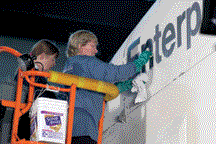 Neal
underwent emergency surgery and spent three months in the hospital and
a convalescent home where she went through rehab "boot camp"
therapy to learn to walk again. Neal
underwent emergency surgery and spent three months in the hospital and
a convalescent home where she went through rehab "boot camp"
therapy to learn to walk again.
"It was four
to six hours a day of taking steps," she said. "My mind knew what to do,
but my legs and feet wouldn't cooperate."
During Neal's
rehabilitation, her best friend and Pi Phi sister Lee Wood visited daily
with encouragement and gifts. Her husband, Sam Wood '71, donated his compact
disc player and some soothing music to ease the long hours of confinement.
When Neal moved to Washington in 1989, she intentionally bought a house
in their neighborhood, and Neal's son instantly had two families.
"When I was
in the hospital, they really lifted my spirits," Neal recalled. "Every
Friday, Lee and I would have a happy hour together. She would bring champagne
glasses and sparkling cider and white linen napkins, and we would sip
and talk.
"She took
me to physical therapy and encouraged me during rehab classes. She never
said this to me, but I think she and others, including my son, probably
thought for a while that I would never walk again. But I knew I would."
Slightly
slower than before, Neal ambles around fine with her cane, even at the
spacious Hazy Center. If only she could do something about its concrete
floor.
As for the
three canes, she said, "If I have to use one, I might as well make a fashion
statement of it."
After Neal
recovered, Wood bought tickets for both of them to attend the ballet and
theater together, resuming their favorite cultural activities.
If there
is someone who can appreciate small tokens, it's Neal.
 One
of her favorite items in the downtown museum is a small box of colored
pencils in an exhibit chronicling the race to space between the Americans
and Soviets. One
of her favorite items in the downtown museum is a small box of colored
pencils in an exhibit chronicling the race to space between the Americans
and Soviets.
The pencils
belong to Russian cosmonaut Aleksi Leonov, who performed the first space
walk. Astronauts say that it is impossible to describe, or even photograph,
the number of hues in the atmosphere from space. Cameras simply cannot
distinguish the many layers. Leonov brought the pencils with him to sketch
what he couldn't find the words for. As a clever engineer, he took string
and fashioned a knot to each of the pencils and tethered each to the box.
Then he devised a bracelet to keep the box around his wrist.
Visitors
may pass over them in the museum's vastness, but the pencils speak volumes
to Neal. "It is so fundamentally human," she said. "It's not science or
technology, Russians or Americans. It's a human being with an artistic
soul thinking ahead to the opportunity that lay before him. The planning
and approach he took shows that he was an engineer, and it was an efficient
solution -- engineering at its simplest.
"Here was
this man who was about to do one of the bravest things a human has ever
done -- go outside a space craft -- and he is thinking about a box of colored
pencils. This small artifact stands in contrast to the big rockets and
complex technology. It humanizes space exploration."
And that's
what Neal sees in her role as caretaker of the nation's most treasured
artifacts. "It is such a privilege to hold the position I have in a place
that is beloved not only by Americans but by people around the world.
About 10 million people a year visit the National Air and Space Museum,
and every time, and I do mean every time, I tell people where I work,
they say, 'Oh that's my favorite museum' or 'I remember going there as
a child and just loved it.' It's truly a great privilege and huge responsibility
to shape exhibits, care for the artifacts and keep the museum a wonderful
place to visit."
It's easy
to see why the museum is thrilled when news cameras come to interview
her, said Walt Ferrell, public affairs specialist for the museum. "People
see her eyes sparkle and her smile as she talks. She translates technical
information in simple language, speaking in pictures and with such passion.
With Valerie, it's never just relaying facts. It's conveying the romance
of space exploration."
Ferrell
recalls the day of the Columbia tragedy. Scores of visitors brought mementos
to leave at the museum's "Space Race" exhibit, which concerned museum
officials about clutter.
"Valerie
embraced that outpouring because she saw it as part of the history of
space exploration and not something to be swept away when the newspaper
faded," he said.
Where
now?
"In the
decades since the launch of Sputnik, the people of the world have thrilled
to the long-dreamed-of moon walks of the Apollo astronauts, marveled at
spectacular photographs of the outer planets brought to us by Voyager,
and watched in horror as the Challenger exploded before our eyes.
No longer the realm of science fiction, space has been hailed in popular
culture as the "final frontier," the focal point of future exploration.
Yet today there is no strong consensus about our future in space. Where
should we go next? Mars? Deep space? Should we continue to send humans
into space? Is it worth the cost to explore space at all?"
- Introduction, Where Next, Columbus?, written by Valerie Neal,
1994
Where next,
Valerie Neal?
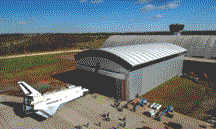 Even
she cannot say. And trying to predict is difficult. Unbridled enthusiasm
works that way. In the mid-1980s, she applied for NASA's Journalist in
Space program and received a postcard the day the Challenger exploded
that her application was under review. The program was canceled. Even
she cannot say. And trying to predict is difficult. Unbridled enthusiasm
works that way. In the mid-1980s, she applied for NASA's Journalist in
Space program and received a postcard the day the Challenger exploded
that her application was under review. The program was canceled.
Just last
year, she wanted to apply again, this time for the Educator in Space program.
With a slight physical disability, she didn't expect to make the first
cut, but she wanted NASA to consider the museum as much an educational
institution as any school.
Most days,
working at a place like the Smithsonian is too great an honor and too
great a challenge to leave.
"I can't
imagine walking away from this job because it is so stimulating, so satisfying,
much the way I imagine teaching would be," she said. "I have one of the
best jobs in the world for its variety, for its impact, for the caliber
of my colleagues, for the chance to meet the public. I can't imagine another
position that offers all those rewards."
Neal said
her coming to the museum was serendipity, that she is an ordinary person
who has had extraordinary opportunities. "I never planned any of this.
I planned to go into an academic career, but wherever I went there were
opportunities. Good luck is opportunity meeting preparation, and my preparation
happened at TCU."
A relocation
back to Texas near her son in Houston and near friends in Fort Worth appeals
to her, as does a teaching position. "I'd
love to teach at my alma mater, even part time as an adjunct professor
-- if they'd have me."
She laughs
and her eyes twinkle.
But immediately
on the horizon is the museum's next major exhibit
-- "The Space Shuttle Era." With advances
to the international space station and findings from
the Mars rovers, it is time for the museum to play
catch-up.
"We haven't
done enough to tell the story about space history from the 1980s forward,"
she said. "The current generations have grown up entirely in the Shuttle
Era. We have to keep pace with them."
She has at
least four or five years to pull it off.
Plenty of
time to think "Where Next, Valerie?"
E-mail
Valerie Neal at Valerie.Neal@nasm.si.edu.
Comment
on this story at tcumagazine@tcu.edu.

Top
|



